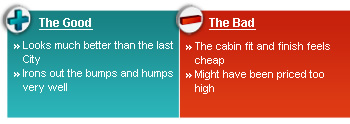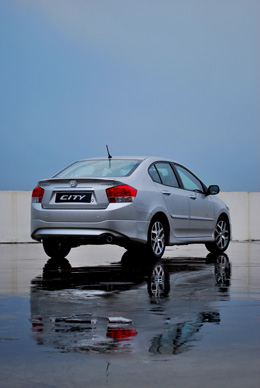Honda City 1.5 LX (A) Review
05 Jan 2009|60,013 views
 |
iously catering to the Asian market, the City was unexcitingly plain and simply just a 'Jazz with a rear'. But it has since adopted a refreshing new look, larger dimensions, increased power and a wider array of features.
While the outgoing Honda City wasn't that much of an eyesore, the latest City has outleaped it by miles. It is a plain Jane no more, having ridded its previous hatchback roots and bearing an "Arrow Shot Form" design that speaks of aggression and boldness. A sharper front with a big slated grille, slit headlights and a swoopy C-pillar completes its sporty look, giving a more obvious progressive design between the City, the Civic and the Accord.
The new City has different engines developed for different markets round the world; the one offered in Singapore is the 1.5-litre i-VTEC engine mated with a five-speed transmission. It is capable of a power output of 120 bhp at 6,600 rpm and a linear torque curve that peaks at 4,800 rpm with 145 Nm. Taking 12.2 seconds to reach 100 km/h from rest, it remains a little above 2,000 revs after - good for fuel consumption.
The drive is typical of a Japanese car, with light steering that lacks feedback and the car starting to shake when pushed past highway speeds. Unless you thrash it, the City is silent with minimal wind or road noise. Other than the paddle-shifters, the City is never going to be a sporty drive. That's all right; its intended role was to provide affordable and functional transport anyway.
 |
The new City has grown 5 mm longer to measure at 4,395 mm and 25 mm wider to measure at 1,715 mm. This results in more interior space within the cabin and two happy adults seated in the back as the rear leg room is generous and headroom is sufficient. Boot space is huge, with a capacity of 506 litres and the capability to house a mountain bike if the 60:40 split-fold rear seats are down.
Inside the cabin, the instrument dials, controls and even the steering wheel are similar to the Jazz. However, there is one distinct difference - the console. The Jazz has this futuristic theme with different-sized dials and an unconventional style, whereas the City has simple dials and straightforward controls.
There's one imperative grouse about the cabin though. It's this sense of inferiority that's so inevitably strong that it undermines all the efforts done on reworking its exterior design. The plastic materials used, for example the centre console, seem cheap and reflect a strong "Made in Thailand" feeling. It is a real pity it is, as the car has done so well on the outside only to be compromised on the inside.
The City is cheap to run, and this fuel efficiency might just be a major drawcard in encouraging buyers out of the compact crossover and mid-sized sedan segments. Interior space within the City has increased much and the sleek styling is hard to ignore. In fact, it is this enhanced styling that might just be enough to overlook the feeling of inferiority exuded when seated within.
Owners of the City probably made their purchase based on the badge and the brand's reputation for technology, as opposed to its rivals' more competitive pricing and reliability factors. With the global economic slowdown, the City might be a popular choice for a downgrade but its pricing does pose a disadvantage. Somehow, even though COE prices are at a low, the City 1.5 LX Automatic's starting price tag of S$61,500 just seems unjustified in my opinion.
Then again, the City does boast of global standards now and has taken on a different positioning. So, will it be technology and style or reliability and consistency? You decide.
 |
iously catering to the Asian market, the City was unexcitingly plain and simply just a 'Jazz with a rear'. But it has since adopted a refreshing new look, larger dimensions, increased power and a wider array of features.
While the outgoing Honda City wasn't that much of an eyesore, the latest City has outleaped it by miles. It is a plain Jane no more, having ridded its previous hatchback roots and bearing an "Arrow Shot Form" design that speaks of aggression and boldness. A sharper front with a big slated grille, slit headlights and a swoopy C-pillar completes its sporty look, giving a more obvious progressive design between the City, the Civic and the Accord.
The new City has different engines developed for different markets round the world; the one offered in Singapore is the 1.5-litre i-VTEC engine mated with a five-speed transmission. It is capable of a power output of 120 bhp at 6,600 rpm and a linear torque curve that peaks at 4,800 rpm with 145 Nm. Taking 12.2 seconds to reach 100 km/h from rest, it remains a little above 2,000 revs after - good for fuel consumption.
The drive is typical of a Japanese car, with light steering that lacks feedback and the car starting to shake when pushed past highway speeds. Unless you thrash it, the City is silent with minimal wind or road noise. Other than the paddle-shifters, the City is never going to be a sporty drive. That's all right; its intended role was to provide affordable and functional transport anyway.
 |
The new City has grown 5 mm longer to measure at 4,395 mm and 25 mm wider to measure at 1,715 mm. This results in more interior space within the cabin and two happy adults seated in the back as the rear leg room is generous and headroom is sufficient. Boot space is huge, with a capacity of 506 litres and the capability to house a mountain bike if the 60:40 split-fold rear seats are down.
Inside the cabin, the instrument dials, controls and even the steering wheel are similar to the Jazz. However, there is one distinct difference - the console. The Jazz has this futuristic theme with different-sized dials and an unconventional style, whereas the City has simple dials and straightforward controls.
There's one imperative grouse about the cabin though. It's this sense of inferiority that's so inevitably strong that it undermines all the efforts done on reworking its exterior design. The plastic materials used, for example the centre console, seem cheap and reflect a strong "Made in Thailand" feeling. It is a real pity it is, as the car has done so well on the outside only to be compromised on the inside.
The City is cheap to run, and this fuel efficiency might just be a major drawcard in encouraging buyers out of the compact crossover and mid-sized sedan segments. Interior space within the City has increased much and the sleek styling is hard to ignore. In fact, it is this enhanced styling that might just be enough to overlook the feeling of inferiority exuded when seated within.
Owners of the City probably made their purchase based on the badge and the brand's reputation for technology, as opposed to its rivals' more competitive pricing and reliability factors. With the global economic slowdown, the City might be a popular choice for a downgrade but its pricing does pose a disadvantage. Somehow, even though COE prices are at a low, the City 1.5 LX Automatic's starting price tag of S$61,500 just seems unjustified in my opinion.
Then again, the City does boast of global standards now and has taken on a different positioning. So, will it be technology and style or reliability and consistency? You decide.
Also read our comparison article on:
Toyota Vios 1.5 G (A) vs Nissan Almera 1.5 Premium (A) vs Honda City 1.5 (A)Car Information
Honda City 1.5 LX (A)
CAT A|Petrol|15.2km/L
Horsepower
89kW (120 bhp)
Torque
145 Nm
Acceleration
12.2sec (0-100km /hr)
This model is no longer being sold by local distributor
All Used Honda CityThank You For Your Subscription.

























